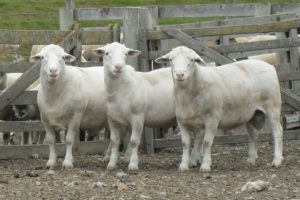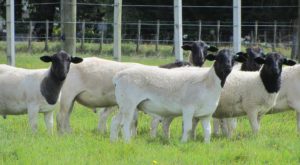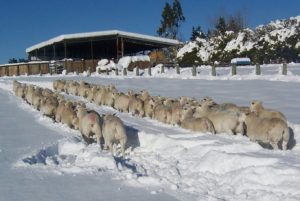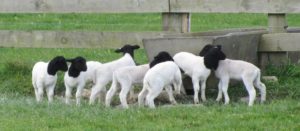Dorper



Dorper Ram wins All Breeds Class – 2017 Mackenzie Highland Show at Fairlie
Bred by A C & K A Lucas of Balclutha
Origin & History
In the 1930’s the South African Department of Agriculture decided to develop a new sheep breed, which had good lambing percentages and produce a high quality carcass.
The Dorper is a cross of the Dorset Horn and a Blackhead Persian. The breeding programme resulted in the Black headed and the White Dorper. The breed is fixed giving reliable reproduction of features and characteristics.
The Dorper is now being bred throughout the Middle East, the USA, South America and Australia.

Breed Standards
A well balanced sheep with strong, deep, wide body and correct legs and feet.
Rams must be well muscled and strong from the front to the back.
Ewes must be lighter in front and getting bigger and heavier to the back. A ewe needs to look feminine head, neck, etc.

Head:
Strong and long with triangle shape. Eyes widely spaced, strong nose and strong mouth with well fitted jaw. Long ears are preferable. Heavy horns are undesirable. The head must be covered with short, dullish, black hair in the Dorper and dull, white hair in the White Dorper.
Neck:
Medium length, well fleshed, broad and well coupled.
Shoulders and Chest:
Shoulders firm, broad and strong. Good muscling on the forearm. A moderate protrusion of the brisket with correct foreleg placement and moderate width between the legs. Shoulders, which appear loose, a brisket which protrudes too much or too little, are faults.
Barrel:
Long, deep and wide body. The sheep must have a long, straight back and not a ‘devil’s grip’. A slight dip behind the shoulders is permissible.
Hindquarter:
Long and wide rump. The inner and outer twist is to be well fleshed and deep.
Legs:
Strong, well placed with strong pasterns and hooves not too widely split. The hocks must be strong without a tendency to turn in or out. Xlegs, sickle or straight hocks are culling faults.
Reproductive Organs:
Scrotum of the ram should not be too long and the testicles should be of equal size and not too small. Well shaped udder and reproductive organs in ewe.
Cover:
The ideal is a short, loose, light mixture of hair and wool and with a natural clean kemp underline in adult sheep.
Colour and Pigmentation:
Good colour and pigmentation.
- Dorpers: A white sheep with black confined to the head and neck is the ideal. Black spots on the body to a limited extent are permissable but it is preferable that a body spot is joined to the neck colour. A blaze must not continue in front of the horn base on the head. An entirely white sheep or a sheep predominately black is not permissable. Brown hair around the eyes, white teats, white under the tail and white hoofs are undesirable.
- White Dorpers: A white sheep, fully pigmented around the eyes, under the tail, on the udder and the teats is ideal. A limited number of other coloured spots is permissible on the ears and underline.
General appearance:
The sheep should be symmetrical and well proportioned. A calm temperament with a vigorous appearance is the ideal.

Presentation of stock:
All stud sheep must be shorn less than 6 weeks or have a cover less than 1.5cm prior to being put in a public auction or competing in show classes at any A. & P. Assn Show.
Stock registration:
For all stud sheep sold, either by public auction or private sale to a new breeder requiring transfer of registration, the stock must be inspected by a registered inspector prior to the said sale. All inspections must be carried out via the New Zealand Sheepbreeders Association (NZSBA). If no inspection sheet is held by the NZSBA for these animal the transfer will not be accepted and the animal will not be able to be registered by the new owner. Animals not sold through public auction or sold to an existing breeder can be registered and transferred without an inspection pass.
Inspections:
The charges for inspecting Dorper sheep are $20.00 for the 1st sheep and $1.00 per sheep thereafter, plus any mileage at the standard rate.
Inspection of Dorper Rams & Ewes:
The inspection of Dorper rams and ewes is voluntary for private sales between registered breeders, but rams and ewes being sold at auction or to a new breeder require inspection. Between breeders either the vendor or purchaser can still require an inspection.
Appendix Flocks:
The grading up code be as follows –
D – ½ bred
C – ¾ bred
B – 7/8th
Basic ewe * stud ram = D ½ bred
D * stud ram = C ¾ bred
C * stud ram = B 7/8th
B * stud ram = A 15/16th
When upgraded ewes and rams are at the 4th cross (15/16 – 93.75%) they can be inspected for registration.
Graded-up rams in Appendix Flocks – a breeder may not use “graded up” rams in Appendix Flocks. Can only use pure (100%) rams.
Dorper Characteristics
Intelligence:
The Dorper is a smart, intelligent sheep that is easy to work with. They are generally quiet to handle, free moving and not aggressive as some breeds. They also have their own unique personalities.
Hardiness:
Able to adapt to any environment, either hot or cold climate. The early imported Dorpers seem to do better on the drier country but with time Dorpers will be able to handle the wetter/heavier country as they adapt to our New Zealand climate.

Grazing Habits:
Dorpers are non-selective grazers. Experience to date in New Zealand is that they are good converters of poorer grasses/paddocks. They graze in a similar manner to a goat and have the ability to graze at a higher level than traditional sheep.
Non-Seasonal Breeding:
Will breed at any time of year with the ability to produce lambs three times in two years, this is happening in New Zealand.
Fertility and Mothering:
Excellent ‘fussing’ mothers who produce good quantities of milk. They are very fertile, generally a first lamber will have one lamb but twins and triplets are common in older ewes.
Growth Rates:
Exceptional growth rates, lambs able to reach 36kgs liveweight in 3.5 to 4 months. The lambs are small at birth but are excellent feed converters; they put all their energy into meat production.
Conformation:
Well put-together carcasses with good fat distribution. New Zealand butchers are very impressed with the half-bred animals they have butchered thus far.
Early Maturers:
Dorpers mature early sexually, ram lambs can begin to work at only 90 days of age, ewes can begin cycling at 5 months of age.
Flystrike:
The wool/hair cover makes the Dorper less prone to flystrike. With the hair cover around the crutch there is little for dags to ‘hang on to’ therefore flystrike is not a big issue. There may be some problems with the “Aussie” fly, which strikes sheep on the shoulders; this will be something that will be watched over the next few seasons.
Worm Tolerance:
The Dorper appears to have a higher tolerance to internal parasites than most other breeds. Already here in New Zealand there have been many cases of Dorpers/half bred Dorpers having high faecal egg counts but looking very healthy compared to other breeds grazing the same paddocks. This allows for less drenching and also makes the Dorper a good proposition for organic meat farming.
Cover Type:
There are two distinct cover types with the Dorper either wool or hair. Both types are good shedders and there appears to be little difference in animals with either cover type. Twin lambs can be born with one being hair covered and the other being wool covered. It is still too early to say which cover type will be best suited for various conditions around New Zealand.
Shedding Ability:
With its wool/hair cover the Dorper is a natural shedder of its fleece meaning shearing is not a necessity. Some animals will shed their entire fleece while others will not shed so well. Under the neck, on the belly and around the breech is always hair only. Having said that, it is up to each individual owner as to whether they wish to ‘tidy up’ their sheep or leave them ‘natural’.
Dermatosparaxis:
This is an inheritable condition in White Dorper sheep where the lamb receives both copies of this recessive gene from its parents. There is a test for this gene and those sheep tested and being non-carries have the symbol (ODCLR) beside them.
Dermatosparaxis Rule for Registered White Dorper Breeders:
All registered rams to be used in studs are to be confirmed as non-carriers of Ovine Dermatosparaxis, but where the ram is tested as a Carrier it can still be used as long as all his progeny that are to be registered, are tested to be non-carriers.
A list of all (ODCLR) animals follows the Dorper section of the Flock Book.
